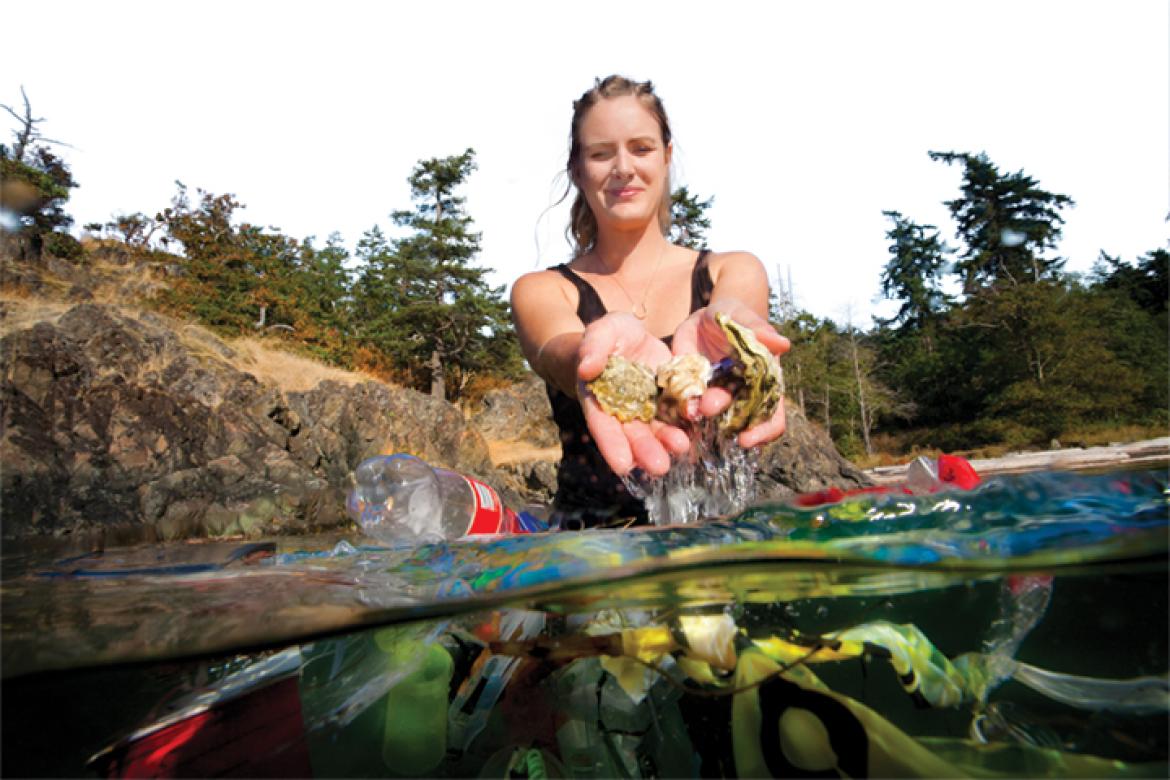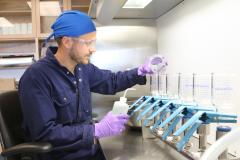
January 8, 2018 - 6:30pm
By Rachel Stern
Scientists don't fully understand the impacts of microplastics on ecosystems, and VIU faculty and students are on the cutting edge of research on the issue.
A rising tide of plastics are floating in the world’s waterways and amongst the debris is a hidden pollutant — microplastics.
Microplastics are smaller than five millimetres, but most are indiscernible to the human eye and require a microscope to see. Larger plastic debris can eventually break down into microplastics due to waves, wind and sun exposure, but the pollutant also exists as either microbeads or microfibres, which come from many consumer products, including clothing.
Microplastics research is still in its infancy and VIU faculty and students are on the cutting edge.
VIU has partnered with Dr. Chris Pierce and Dr. Helen Gurney-Smith from the Department of Fisheries and Oceans, the BC Shellfish Grower’s Association. Dr. John Dower and Dr. Ben Koop from the University of Victoria, and Dr. Peter Ross from the Vancouver Aquarium on research involving shellfish and their environment. Funding from the BCSGA and DFO allowed the university to assemble a team, including three VIU undergraduate students and two VIU alumni, to work on many aspects of microplastic pollution.
Below the Surface
Last year student researchers collected more than 2,000 oysters and 1,000 clams for tagging to monitor microplastics in shellfish.
Dr. Sarah Dudas, a VIU Biology professor, says shellfish were chosen because they are filter-feeding organisms and can potentially concentrate anything that’s present in the water.
“It’s an important topic because we have trillions of plastic particles in our waterways, fresh and marine, and we’ve only been using plastic for about 60 years, so that is mind-blowing,” says Dudas. “We’re not slowing down on our use of plastics, so it’s a problem that is only going to continue to increase and we don’t fully understand what the impacts are on the ecosystems and on the animals that live in those ecosystems.”
Dudas says the BCSGA has been criticized for its use of netting, ropes and other items made of plastic, but there is no direct evidence those items are leading to the microplastics found in shellfish. Growers are concerned about the issue of plastics and their support has been crucial to the success of the project.
Down the Drain
Matt Miller, who recently graduated from VIU with a Bachelor of Science in Fisheries and Aquaculture, worked with growers on his research project, which compared microplastic accumulation in deep-water raft and intertidal beach growing methods. Deep-water oysters are submerged all the time and are constantly feeding while intertidal oysters are exposed to the air and feed less. Miller is still compiling his findings.
“Before I began this work, I knew that microbeads from cosmetic products were ending up in freshwater systems and eventually the ocean and that it wasn’t good for organisms ingesting them,” says Miller. “I didn’t know then that microfibres, not microbeads, seem to be the dominant form of microplastics in the marine environment, and that they are likely coming from textile products such as synthetic clothing.”
The household washing machine is one of the biggest culprits, allowing microfibres to wash down household drains. Every time a piece of synthetic clothing is cleaned in a washing machine it releases thousands of microfibres – tiny pollutants that are too small to be filtered out by wastewater treatment plants.
“There are an estimated 51 trillion microplastic particles in the ocean. That is more than the number of stars in the Milky Way Galaxy,” says Miller, adding he believes people can reduce the number of microplastics entering waterways, but is concerned about the amount already present.
“Microplastics are being ingested by marine organisms, and are likely being passed up the food chain and eventually onto our plates. We still don’t know if this has any effect on our health, but many studies on other organisms have shown negative consequences.”
Purging Particles
Student scientists like Maggie Dietterle, a VIU Biology student, and others in the scientific community, are studying how to remove existing microplastics from the environment and organisms.
Dietterle worked with Dudas and Garth Covernton, a University of Victoria Master’s student, on the oyster and clam tagging and monitoring project and conducted her own research study on depuration. Depuration is a common process used by the shellfish aquaculture industry to remove, or purify, contaminants such as microbes, bacteria and viruses from shellfish before being sent to consumer markets.
Dietterle wanted to determine whether microplastics could be removed from Pacific oysters. First she established a baseline for the average number of microplastics in an oyster and then worked to reduce the number over five days. The method was successful, but Dietterle said because of the extra effort, time and materials required it may not be practical at an industrial scale.
Turning the Tide
Plastics are ubiquitous in the modern world, found in everything from household building materials to electronics and consumer products.
Plastic is also in the air people breathe. Miller said microfibres can come off clothes and carpets. As people go about their daily lives they breathe these tiny pollutants into their lungs. More research is needed to determine how this affects human health, he adds.
Can Plastic be Eliminated from Modern Life?
“Eliminating plastic is completely unrealistic. It really is used in everything,” says Dietterle, adding that knowledge and examining the waste you generate is important. “Spending just five minutes to figure out ways you can reduce your plastics use really could make a difference. We are all in this together and most of us want to take care of the environment. I think everyone has heard this but reducing your use, refusing plastic when you can and recycling really are the keys to helping fight plastic pollution.”
Miller agrees knowledge is crucial.
“Avoiding products that contain microbeads is a given, but focusing on natural fibre clothing such as cotton, bamboo or wool can really make a difference,” he says. “Another big one to avoid is single-use plastics like bags, to-go containers and cutlery. Reducing our plastic consumption will help set an example for the rest of the world and hopefully reduce the amount of plastic being dumped into the oceans.”
SIDEBAR: More about Microplastics
As knowledge about the harmful effects of microplastics on the environment and marine life increases, companies and countries are taking steps to ban the substance from consumer items.
• In the summer of 2015 Loblaws announced it would eliminate the use of microbeads and other harmful ingredients by the end of 2018.
• In 2015 Barack Obama, former United States President, signed the Microbead-Free Waters Act of 2015, which banned rinse-off cosmetics that intentionally added plastic microbeads beginning on January 1, 2018 and to stop the manufacture of these products by July 1, 2017.
• In early 2015, according to United Nations Environment Programme, the Netherlands, Austria, Luxembourg, Belgium and Sweden issued a call to ban microplastics in personal care products.
• In February 2017 the UN Environment launched the #CleanSeas campaign with the goal of eliminating major sources of marine litter, which includes microplastics and single-use plastic, by 2022.
• Canada has also imposed a ban on microbeads in cosmetic products, with these products having until the end of 2018 to be off shelves.
• India recently banned disposable plastic in its capital, Delhi. Cutlery, bags, cups and other forms of single-use plastic are now prohibited.
• Eight million tons of plastics end up in the ocean every year.
• By 2050 there could be more plastic than fish in the ocean.
• By 2050 an estimated 99% of seabirds will have ingested plastic.
• At least 51 trillion microplastic particles are already in the world’s oceans.
• Washing a single synthetic garment in a washing machine releases more than 1,900 microplastic fibres.
*This article originally appeared in the Winter 2017/18 edition of VIU Magazine. Check out more stories on the VIU Magazine webpage.
Tags: Research | VIU Magazine







